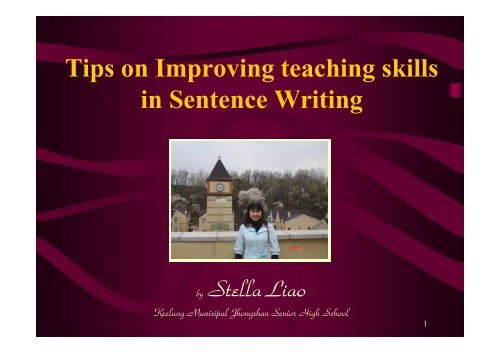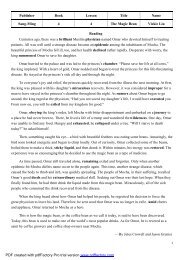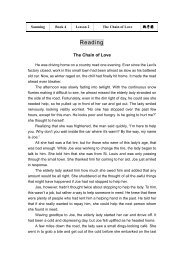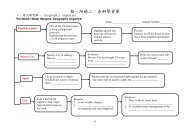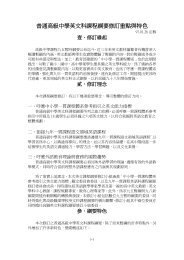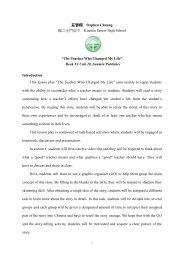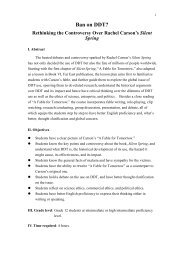Tips on Improving teaching skills in Sentence Writing
Tips on Improving teaching skills in Sentence Writing
Tips on Improving teaching skills in Sentence Writing
You also want an ePaper? Increase the reach of your titles
YUMPU automatically turns print PDFs into web optimized ePapers that Google loves.
<str<strong>on</strong>g>Tips</str<strong>on</strong>g> <strong>on</strong> <strong>Improv<strong>in</strong>g</strong> <strong>teach<strong>in</strong>g</strong> <strong>skills</strong><br />
<strong>in</strong> <strong>Sentence</strong> Writ<strong>in</strong>g<br />
by Stella Liao<br />
Keelung Municipal Jh<strong>on</strong>gshan Senior High School<br />
1
C<strong>on</strong>tents<br />
• Introducti<strong>on</strong> of Teach<strong>in</strong>g Procedures<br />
• Read<strong>in</strong>g Activity<br />
• From Read<strong>in</strong>g to <strong>Sentence</strong> Writ<strong>in</strong>g<br />
• From <strong>Sentence</strong> Writ<strong>in</strong>g to Guided Writ<strong>in</strong>g<br />
• Ways of Correct<strong>in</strong>g <strong>Sentence</strong> Writ<strong>in</strong>g<br />
• Ways of Correct<strong>in</strong>g Guided Writ<strong>in</strong>g<br />
2
Teach<strong>in</strong>g Purpose<br />
• (1) provide simple and <strong>in</strong>terest<strong>in</strong>g methods<br />
for sentence <strong>teach<strong>in</strong>g</strong> that make reluctant<br />
writers feel more comfortable <strong>in</strong> writ<strong>in</strong>g.<br />
• (2) to c<strong>on</strong>nect sentence writ<strong>in</strong>g and guided<br />
writ<strong>in</strong>g with two sentence structures.<br />
• (3) provide simple ways of correct<strong>in</strong>g<br />
writ<strong>in</strong>g that reduce <strong>teach<strong>in</strong>g</strong> pressure <strong>in</strong><br />
class.<br />
3
Text difficulty level:<br />
Elementary<br />
Intermediate (San-M<strong>in</strong>g Publisher, B1L3)<br />
Upper-Intermediate<br />
Advanced<br />
4
<str<strong>on</strong>g>Tips</str<strong>on</strong>g> <strong>on</strong> <strong>Improv<strong>in</strong>g</strong><br />
your memory<br />
Teach<strong>in</strong>g<br />
Procedure<br />
<strong>Sentence</strong><br />
Pattern<br />
Abstract<br />
Gerunds<br />
The more..<br />
Guided<br />
Writ<strong>in</strong>g<br />
<strong>Sentence</strong><br />
rewrit<strong>in</strong>g<br />
F<strong>in</strong>d<strong>in</strong>g<br />
mistakes<br />
Correcti<strong>on</strong><br />
<strong>Sentence</strong><br />
writ<strong>in</strong>g<br />
translati<strong>on</strong>s<br />
5
Read<strong>in</strong>g Activity<br />
6
Present<strong>in</strong>g the Text<br />
Pre-Read<strong>in</strong>g Activity<br />
• Read a set of numbers<br />
and ask students to<br />
memorize it.<br />
• Check how many students<br />
can remember all the<br />
numbers correctly.<br />
• Bra<strong>in</strong>storm. Ss freely<br />
express “how” they<br />
memorized these items.<br />
• Share the useful memory<br />
tips from the text.<br />
7
<str<strong>on</strong>g>Tips</str<strong>on</strong>g> <strong>on</strong> <strong>Improv<strong>in</strong>g</strong> your Memory<br />
□Tip 1: Set realistic goal.<br />
□ Tip 2: Stay mentally active.<br />
□ Tip 3: Cut down <strong>on</strong> activities that<br />
d<strong>on</strong>’t require you to th<strong>in</strong>k.<br />
□ Tip 4: Read more.<br />
□ Tip 5: Teach others what you know.<br />
□ Tip 6: Improve your vocabulary.<br />
□ Tip 7: Get <strong>in</strong>to the habit of tak<strong>in</strong>g<br />
notes<br />
*Check if I follow the rules <strong>in</strong> learn<strong>in</strong>g.<br />
8
Dur<strong>in</strong>g Read<strong>in</strong>g Activity<br />
Theme of the less<strong>on</strong>:<br />
1. The less<strong>on</strong> describes some tips for<br />
improv<strong>in</strong>g the memory;<br />
2. another theme c<strong>on</strong>cerns how students can<br />
use these tips <strong>in</strong> their studies to make<br />
learn<strong>in</strong>g more effective.<br />
10
Dur<strong>in</strong>g Read<strong>in</strong>g Activity<br />
Students’ Role:<br />
• Be <strong>in</strong> charge of <strong>on</strong>e tip for improv<strong>in</strong>g the memory,<br />
• Discuss the relevant examples.<br />
• Figure out the most useful tip with examples.<br />
• A spokespers<strong>on</strong> presents the results of their<br />
discussi<strong>on</strong>.<br />
The teacher’s Role<br />
• corrects errors <strong>in</strong> the presentati<strong>on</strong>s,<br />
• teaches the key ideas of the text,<br />
• <strong>in</strong>troduces essential sentence<br />
• patterns to the class.<br />
11
<str<strong>on</strong>g>Tips</str<strong>on</strong>g> of<br />
Abstract<br />
self-evaluati<strong>on</strong><br />
peer-evaluati<strong>on</strong><br />
With checklist<br />
Writ<strong>in</strong>g<br />
highlight ma<strong>in</strong> ideas<br />
Write them down<br />
Close the book<br />
Checklists<br />
□key sentence<br />
□with proper pers<strong>on</strong><br />
□with proper tense<br />
□with transiti<strong>on</strong>al<br />
words<br />
□rewrite the sentence<br />
Rewrite<br />
Comb<strong>in</strong>e sentences<br />
With c<strong>on</strong>juncti<strong>on</strong>s<br />
13
Checklists<br />
□with key sentences<br />
□with proper pers<strong>on</strong>s<br />
□with proper tenses<br />
□with transiti<strong>on</strong>al words<br />
□rewrite the sentences<br />
3 Positive commands:<br />
_______________________<br />
14
<str<strong>on</strong>g>Tips</str<strong>on</strong>g> <strong>in</strong> <strong>teach<strong>in</strong>g</strong> the abstract<br />
• usage of the recycl<strong>in</strong>g paper time<br />
sav<strong>in</strong>g.<br />
• Usage of Checklists help Ss be aware<br />
of the writ<strong>in</strong>g procedure.<br />
• Usage of peer evaluati<strong>on</strong> Practice<br />
makes perfect, <strong>in</strong>stead of Correcti<strong>on</strong><br />
makes depressi<strong>on</strong><br />
16
From Read<strong>in</strong>g to <strong>Sentence</strong> writ<strong>in</strong>g<br />
17
Teach<strong>in</strong>g<br />
Procedure<br />
<strong>Sentence</strong><br />
Patterns<br />
Gerunds<br />
The more…,<br />
The more….<br />
<strong>Sentence</strong><br />
Rewrit<strong>in</strong>g<br />
<strong>Sentence</strong><br />
mak<strong>in</strong>g<br />
F<strong>in</strong>d<strong>in</strong>g<br />
Mistakes Translati<strong>on</strong>s<br />
Standard<br />
of JECC<br />
Selected<br />
correcti<strong>on</strong><br />
Checklist<br />
18
Ss write their favorite<br />
sentence <strong>on</strong> the board.<br />
Ss’ Learn<strong>in</strong>g<br />
Process<br />
Ss do the presentati<strong>on</strong><br />
<strong>in</strong> class.<br />
Ss fill <strong>in</strong> their answers<br />
of the worksheet with<br />
the checklist<br />
Students are tra<strong>in</strong>ed to be familiar<br />
to the use of this sentence practice.<br />
The teacher checks the<br />
exercise <strong>in</strong> open class<br />
19
1.Gerund “V-<strong>in</strong>g + V+ O.”<br />
1-1.<strong>Sentence</strong> Rewrit<strong>in</strong>g<br />
• Directi<strong>on</strong>s:<br />
• 4 <strong>in</strong> <strong>on</strong>e group.<br />
• do the exercise before the class.<br />
• exchange homework.<br />
• Peer-evaluati<strong>on</strong>.(checklist)<br />
• The teacher elicits this<br />
sentence pattern<br />
expla<strong>in</strong>s the essential<br />
c<strong>on</strong>cepts.<br />
20
<strong>Sentence</strong> Rewrit<strong>in</strong>g: <str<strong>on</strong>g>Tips</str<strong>on</strong>g> of the<br />
checklist Edit<br />
Ss do the pre-tests of<br />
sentence patterns.<br />
The teacher comb<strong>in</strong>es the<br />
general grammar mistakes<br />
of Ss.<br />
Checklist of Gerunds:<br />
Group: Name: No. ___<br />
Excellent Good Below Average<br />
□ □ □ VV<strong>in</strong>g<br />
□ □ □ V-<strong>in</strong>g+<br />
S<strong>in</strong>gle verb +O.(or S+V+ V-<strong>in</strong>g)<br />
□ □ □ <strong>Sentence</strong><br />
complete with high level of<br />
understand<strong>in</strong>g.<br />
21
1-1.Handout:<br />
Explanati<strong>on</strong>s of Gerunds<br />
• 動 名 詞 是 由 「 原 形 動 詞 ┼V<strong>in</strong>g」, 如 runn<strong>in</strong>g,<br />
talk<strong>in</strong>g.<br />
• 動 名 詞 與 不 定 詞 都 是 動 詞 的 演 變 , 雖 有 動 詞 的<br />
樣 子 , 但 已 經 不 再 是 動 詞 , 而 是 「 名 詞 」。<br />
• 基 本 出 現 位 置 : 當 主 詞 、 受 詞 、 與 補 語 。<br />
Learn<strong>in</strong>g danc<strong>in</strong>g is fun. (S)<br />
• 動 名 詞 與 不 定 詞 作 為 名 詞 時 , 都 接 單 數 動 詞 。<br />
E.g. Chatt<strong>in</strong>g to with them improves my m<strong>in</strong>d.<br />
22
1-1. Handout:<br />
Examples:<br />
Explanati<strong>on</strong>s of Gerunds<br />
• I must _____ mak<strong>in</strong>g mistakes aga<strong>in</strong>.<br />
• He _____ hav<strong>in</strong>g seen the man before.<br />
• 他 延 遲 回 信 。<br />
• 他 把 訪 友 的 事 延 後 。<br />
• 我 們 正 考 慮 要 去 參 加 一 些 課 外 活 動 。<br />
• 我 再 也 抗 拒 不 了 了 , 所 以 決 定 打 一 下 午 的 電 動<br />
遊 戲 。<br />
23
<strong>Sentence</strong><br />
Rewrit<strong>in</strong>g:<br />
Part C<br />
24
1.Gerund “V-<strong>in</strong>g + V+ O.”<br />
1-2. Mak<strong>in</strong>g up <strong>Sentence</strong>s<br />
• Directi<strong>on</strong>s:<br />
• 1. Ss fill <strong>in</strong> their answers of the worksheet<br />
with the checklist <strong>in</strong> class.<br />
• 2. Ss write their favorite sentence <strong>on</strong> the<br />
board.<br />
• 5. The teacher checks the exercise <strong>in</strong> open<br />
class, ask<strong>in</strong>g learners to justify their<br />
answers by the reference <strong>on</strong> their<br />
worksheets.<br />
• 6. Students are tra<strong>in</strong>ed to be familiar to the<br />
use of this sentence practice <strong>in</strong> handy.<br />
25
1.Gerund “V-<strong>in</strong>g + V+ O.”<br />
1-2. Mak<strong>in</strong>g up <strong>Sentence</strong>s<br />
Checklist: Name________ No.__<br />
Excellent Good Below Average<br />
□ □ □ V<strong>in</strong>g + s<strong>in</strong>gle verb + O.<br />
□ □ □ The verb tense is c<strong>on</strong>sistent.<br />
□ □ □ <strong>Sentence</strong>s are complete<br />
□ □<br />
of Understand<strong>in</strong>g.<br />
□ <strong>Sentence</strong>s show a high level<br />
26
Mak<strong>in</strong>g up<br />
<strong>Sentence</strong>s<br />
27
1.Gerund “V-<strong>in</strong>g + V+ O.”<br />
The E-factors<br />
• Ec<strong>on</strong>omy: Checklists help Ss be aware of<br />
the rule directly.<br />
• Efficiency: Ss preview the background<br />
knowledge by do<strong>in</strong>g the exercise at home.<br />
28
2.“the more…, the more….”:<br />
2-1.F<strong>in</strong>d<strong>in</strong>g mistakes : Directi<strong>on</strong>s<br />
The teacher deduces<br />
all the sentences<br />
with the target<br />
pattern from the text<br />
Students discuss the<br />
sentences with each other to<br />
f<strong>in</strong>d errors <strong>in</strong> the usage of<br />
the pattern .<br />
The teacher elicits sentence patterns from<br />
the class and corrects errors written<br />
<strong>on</strong> the board by students.<br />
The teacher goes<br />
around the class to help<br />
<strong>in</strong>dividual students with<br />
their problems.<br />
29
Error<br />
Modificati<strong>on</strong><br />
30
2.“the more…, the more….”:<br />
2-2.Do<strong>in</strong>g Translati<strong>on</strong>s<br />
• Translati<strong>on</strong> <strong>in</strong> Series<br />
• 1 你 愈 了 解 他 , 你 就 會 愈 喜 歡 他 。<br />
• The more you realize him, the more you<br />
like him.<br />
• 2. 一 個 人 的 年 紀 愈 大 , 記 性 就 愈 差 。<br />
• The older a pers<strong>on</strong> grows, the poorer<br />
memory he will have.<br />
31
2-3.Def<strong>in</strong>iti<strong>on</strong> of <strong>Sentence</strong> Errors<br />
• Lexical errors: <strong>in</strong>clude<br />
the wr<strong>on</strong>g word order<br />
(Sett<strong>in</strong>g realistic goal is<br />
good for your lie.life)<br />
• Grammar errors:<br />
<strong>in</strong>clude the mistakes <strong>in</strong><br />
verb form, tense, or<br />
adjectives<br />
(Stay<strong>in</strong>g mentally active<br />
makes us more sharp.<br />
shaper)<br />
Lower-leveled Ss<br />
Discourse errors:<br />
relate to the way<br />
sentence are<br />
organized and liked<br />
<strong>in</strong> order to make a<br />
complete text<br />
(Sett<strong>in</strong>g realistic helps<br />
us to do quickly. <br />
everyth<strong>in</strong>g)<br />
Higher-leveled Ss<br />
Freshmen make more<br />
mistakes of lexical and<br />
grammar errors <strong>in</strong> general. 32
<strong>Sentence</strong> Patterns<br />
The E-factors<br />
• Ease: the same format of the geographic<br />
organizer expand<strong>in</strong>g learn<strong>in</strong>g ease the<br />
<strong>teach<strong>in</strong>g</strong> load. (1-2 Mak<strong>in</strong>g up sentences)<br />
• Efficiency: the background knowledge<br />
from the text the new sentence<br />
pattern.<br />
(1-1 sentence rewrit<strong>in</strong>g, 2-1 F<strong>in</strong>d<strong>in</strong>g Errors)<br />
• Ec<strong>on</strong>omy: students can transfer<br />
the sentence pattern to<br />
daily life usage.<br />
(1-2 Mak<strong>in</strong>g up <strong>Sentence</strong>s, 2-2 Do<strong>in</strong>g Translati<strong>on</strong>s)<br />
33
From <strong>Sentence</strong> Writ<strong>in</strong>g<br />
to Guided Writ<strong>in</strong>g<br />
34
3. Guided Writ<strong>in</strong>g: Self-Introducti<strong>on</strong><br />
• students represent their work, with the<br />
power-po<strong>in</strong>t or the poster, <strong>in</strong> fr<strong>on</strong>t of<br />
the class.<br />
•The teacher hands out an<br />
autobiography table designed to<br />
assist students to write the essay.<br />
35
3. Guided Writ<strong>in</strong>g:<br />
Self-Introducti<strong>on</strong><br />
• Directi<strong>on</strong>s:<br />
• Take notes<br />
• Do the group discussi<strong>on</strong><br />
• F<strong>in</strong>ish the first draft after<br />
class.<br />
• Do the modificati<strong>on</strong> and<br />
turns <strong>in</strong> the f<strong>in</strong>ished essay.<br />
• corrects the essay and<br />
commands the general<br />
mistakes.<br />
36
Ways of correct<strong>in</strong>g<br />
sentence writ<strong>in</strong>g<br />
37
How to resp<strong>on</strong>d to students’ works<br />
• Teacher’s Role : the exam<strong>in</strong>er, the audience, the<br />
evaluator, or the c<strong>on</strong>sultant.<br />
• Ways of resp<strong>on</strong>d<strong>in</strong>g:<br />
1.self-correcti<strong>on</strong>,<br />
2. peer-evaluati<strong>on</strong>,<br />
3. group discussi<strong>on</strong><br />
the teacher uses self-correcti<strong>on</strong>, peer-evaluati<strong>on</strong>,<br />
and group discussi<strong>on</strong> effectively <strong>in</strong> class, po<strong>in</strong>t<strong>in</strong>g<br />
out grammar errors from groups, and further us<strong>in</strong>g<br />
these errors to make impromptu <strong>teach<strong>in</strong>g</strong> po<strong>in</strong>ts<br />
for the whole class.<br />
38
Advantages<br />
• these practices arouse students’<br />
learn<strong>in</strong>g motivati<strong>on</strong><br />
• provide an ec<strong>on</strong>omical means of<br />
giv<strong>in</strong>g feedback from the teacher.<br />
• ease the workload of the teacher<br />
<strong>in</strong> correct<strong>in</strong>g students’ <strong>in</strong>dividual<br />
assignments.<br />
39
2. Ways of correct<strong>in</strong>g sentence writ<strong>in</strong>g<br />
1. standards for sentence correcti<strong>on</strong><br />
from CEEC (College Entrance<br />
Exam<strong>in</strong>ati<strong>on</strong> Center)<br />
2. Selective correcti<strong>on</strong><br />
3. Us<strong>in</strong>g checklists with peer<br />
evaluati<strong>on</strong><br />
40
2-1. Standard of sentence correcti<strong>on</strong><br />
from CECE<br />
• each sentence is divided<br />
<strong>in</strong>to two clauses<br />
• each error will be counted<br />
per time, with no repeated<br />
count<strong>in</strong>g .<br />
• the same spell<strong>in</strong>g error is<br />
counted <strong>on</strong>e time <strong>on</strong>ly.<br />
Errors <strong>in</strong> punctuati<strong>on</strong> are<br />
<strong>on</strong>ly counted <strong>on</strong>ce.<br />
大 學 入 學 考 試 中 心 英 文 科 評<br />
分 標 準 :<br />
(1) 本 大 題 總 分 8 分 , 每 小<br />
題 滿 分 4 分 。<br />
(2) 每 個 錯 誤 扣 0.5 分 , 扣<br />
完 為 止 。<br />
(3) 相 同 之 拼 字 錯 誤 只 扣 分<br />
一 次 。<br />
(4) 句 首 未 大 寫 或 標 點 符 號<br />
不 妥 , 各 扣 0.5 分 , 只 扣 一<br />
次 。<br />
41
Advantages & Disadvantages<br />
• Advantages: students can become aware of<br />
how to get high scores by c<strong>on</strong>form<strong>in</strong>g to the<br />
correcti<strong>on</strong> standards <strong>on</strong> tests .<br />
• Disadvantages:<br />
1. students might still f<strong>in</strong>d that their work<br />
quickly becomes covered <strong>in</strong> red <strong>in</strong>k.<br />
2. this k<strong>in</strong>d of correcti<strong>on</strong> is extremely timec<strong>on</strong>sum<strong>in</strong>g<br />
for the teacher .<br />
42
2-2. Selective correcti<strong>on</strong><br />
• students usually make mistakes “more happier” or<br />
“more fatter” <strong>in</strong> practic<strong>in</strong>g the sentence pattern,<br />
“the + adj-er…, the + adj-er…”<br />
• the teacher can provide sentences c<strong>on</strong>ta<strong>in</strong><strong>in</strong>g these<br />
types of errors <strong>on</strong> worksheets to help them avoid<br />
such grammar mistakes.<br />
• ask<strong>in</strong>g students to keep a log of errors can<br />
assist them to avoid repeat<strong>in</strong>g the same<br />
errors <strong>on</strong> their next assignment.<br />
43
2-3. Us<strong>in</strong>g checklists with peer<br />
evaluati<strong>on</strong><br />
• It encourages students to work<br />
collaboratively and ga<strong>in</strong> knowledge <strong>in</strong> a<br />
supportive atmosphere .<br />
• students are tra<strong>in</strong>ed to use the checklist to<br />
evaluate each other’s work and give<br />
professi<strong>on</strong>al comments, which helps them<br />
to achieve a better level <strong>in</strong> their own writ<strong>in</strong>g.<br />
44
3.Ways of correct<strong>in</strong>g essay writ<strong>in</strong>g<br />
• 1. Us<strong>in</strong>g rubrics<br />
• 2. Referr<strong>in</strong>g students<br />
to a dicti<strong>on</strong>ary or a<br />
grammar book<br />
• 3. Resp<strong>on</strong>d<strong>in</strong>g by<br />
written comment<br />
45
3.Essay Writ<strong>in</strong>g Correcti<strong>on</strong><br />
3-1. Us<strong>in</strong>g rubrics<br />
3 2 1 comments<br />
Format<br />
Structure<br />
The first l<strong>in</strong>e of the paragraph is<br />
<strong>in</strong>dented 5 spaces.<br />
<strong>Sentence</strong>s fit <strong>in</strong>side the marg<strong>in</strong>s<br />
given <strong>in</strong> the assignment.<br />
Paragraphs average 4 to 8 sentences<br />
<strong>in</strong> length.<br />
Each paragraph has <strong>on</strong>e, and <strong>on</strong>ly<br />
<strong>on</strong>e, ma<strong>in</strong> idea.<br />
46
3.Essay Writ<strong>in</strong>g Correcti<strong>on</strong><br />
3-1. Us<strong>in</strong>g rubrics<br />
Structure<br />
Grammar<br />
3 2 1 comments<br />
All detail sentences relate to the ma<strong>in</strong> idea<br />
of each paragraph.<br />
<strong>Sentence</strong>s are free of spell<strong>in</strong>g errors.<br />
<strong>Sentence</strong>s fit the grammatical structure<br />
“S+V+O.”<br />
The tense is c<strong>on</strong>sistent throughout the<br />
paper and especially with<strong>in</strong> a paragraph.<br />
<strong>Sentence</strong> Pattern <strong>in</strong> the autobiography fits<br />
the syntax, “The adj-er…, the adj-er…”<br />
47
3.Essay Writ<strong>in</strong>g Correcti<strong>on</strong><br />
3-2.Us<strong>in</strong>g a dicti<strong>on</strong>ary or a grammar book<br />
• ask students to c<strong>on</strong>sult a grammar book to<br />
compare correct and <strong>in</strong>correct sentences <strong>in</strong><br />
their writ<strong>in</strong>g .<br />
• ask the student to c<strong>on</strong>sult a grammar book<br />
to see if they made a lexical error, grammar<br />
error, or discourse error .<br />
48
3.Essay Writ<strong>in</strong>g Correcti<strong>on</strong><br />
3-3. Resp<strong>on</strong>d<strong>in</strong>g by written comment<br />
• the teacher can both use the mark<strong>in</strong>g scale<br />
and written comments to suggest students<br />
do better <strong>in</strong> their f<strong>in</strong>al essay.<br />
• it is vital to be encourag<strong>in</strong>g and helpful<br />
rather than judgmental.<br />
49
4.Student’s Work:<br />
My name is Yu Hsuan Li. I was<br />
born <strong>in</strong> December and my star sign<br />
at birth is Sagittarius. This star<br />
sign presents full of energy and<br />
be<strong>in</strong>g active. But these<br />
pers<strong>on</strong>alities <strong>on</strong>ly appear when I<br />
get al<strong>on</strong>g with my close friend. My<br />
favorite color is blue because it<br />
makes me fell sooth<strong>in</strong>g.<br />
• At school, I am good at Ch<strong>in</strong>ese;<br />
therefore, the more time I spend<br />
<strong>on</strong> read<strong>in</strong>g, the more clear my<br />
bra<strong>in</strong> becomes. In the free time, I<br />
like read<strong>in</strong>g fantastic novels. The<br />
more often I read fantastic novels,<br />
the more imag<strong>in</strong>ative I become.<br />
The seas<strong>on</strong> that <strong>in</strong>fluences me the<br />
most is w<strong>in</strong>ter because the cold air<br />
always makes me headache and<br />
have a runn<strong>in</strong>g nose. Someday, I<br />
hope to be a screenwriter.<br />
50
Teacher’s written comments:<br />
• I enjoyed your self<strong>in</strong>troducti<strong>on</strong><br />
very much.<br />
• I liked the descripti<strong>on</strong> of your<br />
pers<strong>on</strong>alities. They <strong>in</strong>deed<br />
represent your<br />
characteristics.<br />
• I have <strong>on</strong>e or two suggesti<strong>on</strong>s<br />
to make:<br />
51
Teacher’s written comments:<br />
1. How about giv<strong>in</strong>g more examples to describe<br />
more about your pers<strong>on</strong>alities<br />
It would be a good way to know you <strong>in</strong><br />
different angles.<br />
2. I wouldn’t <strong>in</strong>clude the bit about your favorite<br />
seas<strong>on</strong> s<strong>in</strong>ce it gets <strong>in</strong> the way of your<br />
autobiography.<br />
3. Be careful with your use of adjectives, the<br />
+adj.+er.<br />
Check the grammar book of the usage.<br />
52
On Exhibiti<strong>on</strong>s<br />
53


